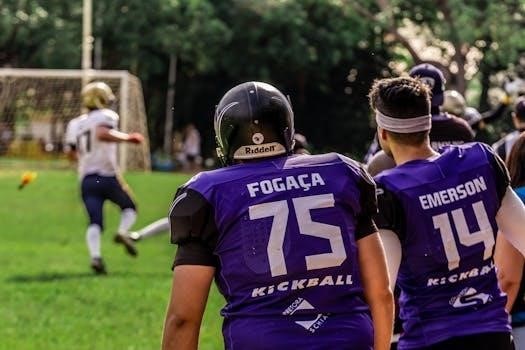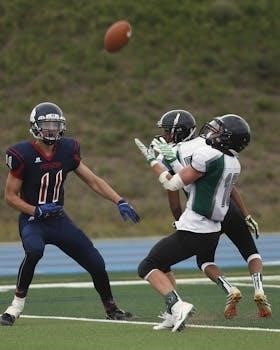
Pistol Offense⁚ A Comprehensive Playbook Guide
The pistol formation, a hybrid of shotgun and single-back, offers diverse play options. This comprehensive guide explores the nuances of this offense, emphasizing its flexibility. We delve into its use for both pass and run schemes. This playbook will equip you to master this versatile offensive approach.
The pistol formation represents a strategic blend of the shotgun and single-back offenses, creating a dynamic hybrid system. In this setup, the quarterback aligns approximately three to four yards behind the center, a position tighter than a traditional shotgun. The running back positions himself directly behind the quarterback. This alignment provides a unique vantage point for both run and pass plays, allowing for greater deception and versatility. The pistol formation’s emergence has been driven by its capacity to balance offensive attacks, eliminating some tendencies commonly associated with zone read games. This formation forces defenses to adjust and allows for the seamless integration of a full option package. The ability to run a base two-back offense from a shotgun-like position adds another layer of complexity, creating significant conflict within the defensive ranks. This introduction sets the stage for a deeper exploration of the intricacies and advantages of the pistol offense, highlighting its role in modern football strategy. Its adaptability allows for the easy integration of diverse play styles and strategies.
Key Principles of the Pistol Offense
The pistol offense is anchored by several key principles designed to maximize its effectiveness. Central to its philosophy is the creation of offensive balance, forcing defenses to respect both the run and the pass. A core principle lies in the quarterback’s positioning, which is closer to the line of scrimmage than in a traditional shotgun formation, facilitating quicker handoffs and reads. This proximity enhances the option game, allowing the quarterback to react swiftly to defensive alignments and make split-second decisions. Another crucial principle is the utilization of visual variety to disguise play intentions, masking execution patterns by using different formations. Zone blocking is a fundamental aspect, allowing for flexibility and adaptability in the running game. The pistol offense also promotes misdirection, incorporating elements from the Wing-T to create confusion and open up running lanes. The ability to flip plays without altering running back positioning adds to the offense’s adaptability. Furthermore, the seamless integration of run and pass concepts ensures the offense remains unpredictable and challenging for defenses to anticipate. These principles combined form the backbone of the pistol offense, making it a potent and versatile strategy.
Quarterback Alignment and Responsibilities
In the pistol formation, the quarterback’s alignment is a critical component, typically positioning them approximately three to four yards directly behind the center. This placement is shallower than in a traditional shotgun, enabling quicker handoffs to the running back and facilitating faster reads on option plays. The quarterback’s responsibilities are multifaceted, beginning with pre-snap reads to assess the defensive formation and adjust accordingly. Post-snap, the quarterback must execute handoffs with precision, read defensive keys for option plays, and make quick decisions on whether to hand the ball off or keep it. A vital role is to be a dual-threat, capable of running the ball effectively when necessary, adding a further layer of complexity for the defense. Furthermore, the quarterback is responsible for executing passing plays, including short, quick passes, as well as longer downfield throws. He is also key in managing the flow of the game, making play calls, and directing the offense efficiently. The quarterback’s ability to quickly process information, coupled with accuracy and agility, are essential to the success of the pistol offense.
Running Back Positioning and Footwork
In the pistol formation, the running back typically aligns directly behind the quarterback, usually positioned about six to seven yards off the line of scrimmage. This alignment is crucial for the effectiveness of the pistol offense, allowing for both powerful runs and quick pass receptions. The running back’s footwork is paramount; they must possess the agility to make sharp cuts and change direction quickly. Footwork is critical for executing various plays, including zone runs, power runs, and option plays where they may receive a handoff or be a decoy. During handoffs, the running back must aim for a smooth exchange with the quarterback, maintaining a consistent path and keeping the ball secure. Furthermore, on pass plays, the running back must be capable of running precise routes, catching the ball cleanly, and gaining yards after the catch. They also need to be proficient in pass protection, picking up blitzing linebackers or defensive backs. The running back’s ability to quickly accelerate, make decisive reads, and maintain balance are key to the pistol offense’s effectiveness. Their role demands a combination of speed, power, and agility, making them a crucial component in the offensive scheme.
Offset I Formation⁚ The Base of the Pistol

The Offset I formation serves as a foundational element within the pistol offense, providing a balanced approach to both running and passing plays. In this formation, the quarterback lines up approximately three to four yards behind the center, taking the snap in a shotgun style. The running back positions himself directly behind the quarterback, typically offset slightly to one side, creating an “I” formation that is not perfectly aligned. This offset positioning allows for multiple advantages, including versatile run angles and passing opportunities. The tight end and flanker are generally positioned on the right side of the formation. This alignment can create a strong side for running plays, as well as providing a potential passing threat. The offensive line is arranged in a standard manner, focusing on creating gaps and protecting the quarterback. From this base, the offense can implement various run schemes, such as zone blocking and power runs, while also having the flexibility to execute play-action passes and quick routes. The Offset I is crucial for providing balance, versatility, and multiple options. This formation allows the offense to be unpredictable and difficult to defend. It allows for a powerful running attack, as well as the ability to pass effectively.
Zone Blocking Schemes in the Pistol
Zone blocking is a critical component of the pistol offense, designed to create running lanes through coordinated movement and teamwork along the offensive line. Unlike man blocking, where each lineman is assigned a specific defender, zone blocking requires linemen to move in unison, taking responsibility for blocking an area rather than an individual. In the pistol formation, this scheme is particularly effective because it allows for the quarterback and running back to make reads and adjustments based on the flow of the defense. The offensive line will typically block to the play side, creating a wall and allowing the running back to find an opening. Linemen execute reach blocks, down blocks, and double teams to secure the area. The quarterback’s positioning in the pistol makes it easy to execute zone read plays, where he decides whether to hand off to the running back or keep the ball, based on how the defensive end reacts. This system is very versatile, and it helps teams to create consistent running gains. Zone blocking allows teams to move the line of scrimmage and create holes for the runners. It’s a core part of the pistol’s offensive effectiveness. The scheme also helps linemen become more athletic, as they are asked to move quickly and efficiently.

Option Plays and the Zone Read
Option plays and the zone read are integral to the pistol offense, providing a dynamic and unpredictable attack that keeps defenses guessing. The zone read, a cornerstone of this approach, places the quarterback in a position to make a crucial decision post-snap, based on the reaction of a designated defender, often the defensive end. The quarterback reads this defender⁚ if the defender crashes down to tackle the running back, the quarterback keeps the ball and runs; if the defender stays wide, the quarterback hands off to the running back. This simple read creates a two-on-one scenario where the offense has the advantage. Option plays extend beyond the zone read, incorporating various pitch and keep options, using multiple running backs and creating different angles of attack. These plays are designed to maximize the athleticism of the quarterback and running back. The pistol formation enhances these plays by allowing the quarterback to make quick reads and decisions. The backfield action allows for multiple option routes to be tagged on any play. The zone read in particular is very popular in the pistol formation. These plays force defenses to commit and react to the flow of the play. By using these types of plays, the offense is always one step ahead of the defense.
Passing Concepts from the Pistol
The pistol formation provides a versatile platform for a wide array of passing concepts, offering quarterbacks the ability to launch both short and deep attacks. The quarterback’s alignment, slightly behind the center, provides a clear view of the field and allows for quick decision making. From this position, quick passing plays can be executed effectively. These include slant routes, flat routes, and quick outs, which are often used to move the chains and create opportunities after the catch. The pistol also supports deeper passing plays such as post routes, corner routes, and go routes, providing opportunities for big plays. Play action passes are particularly effective out of the pistol, as the backfield action can mimic run plays, drawing defenders in and creating space for receivers. The use of multiple formations, including twins or trips, allows for complex route combinations that stretch the defense horizontally and vertically. The QB can easily read the defense and choose the appropriate passing route. The pistol’s flexibility makes it a formidable formation in any passing game. These passing concepts allow for many opportunities to score from anywhere on the field.

Integrating Wing-T Principles with the Pistol
Integrating Wing-T principles with the pistol formation creates a dynamic and deceptive offensive system. The Wing-T’s emphasis on misdirection, power running, and play-action passing blends seamlessly with the pistol’s shotgun-like flexibility. This fusion allows for a multi-faceted attack that keeps defenses off balance. The core of the Wing-T, with its tight formations and multiple lead blockers, can be effectively implemented from the pistol. This includes the use of pulling guards and tackles to create angles for the run game. The backfield action from the Wing-T, featuring fullback dives, traps, and sweeps, can be modified to fit the pistol’s backfield alignment. The pistol formation’s ability to run option plays, combined with the Wing-T’s misdirection, can add an additional layer of complexity for opposing defenses. The play-action passing game from the Wing-T, characterized by bootlegs and waggles, can be adapted to the pistol’s quarterback positioning. This blend allows for a seamless transition between run and pass. The Wing-T’s use of unbalanced lines and motion can further enhance the pistol’s deceptive nature. This integration provides a unique offensive approach that’s difficult to defend. This combination creates a potent offensive system that can dominate the field.
Play Calling Strategies in the Pistol
Effective play calling in the pistol offense involves a strategic blend of run and pass plays to keep defenses guessing. A crucial element is establishing a strong running game early, utilizing the pistol’s versatility with inside and outside zone plays, along with power running schemes. Incorporating option plays, such as the zone read, can add another layer of complexity, forcing defenses to account for the quarterback’s running threat. Play-action passing becomes an essential component, drawing defenders closer to the line of scrimmage, creating opportunities for downfield throws. Variety in formations and personnel groupings can further confuse defenses. Utilizing different backfield sets and tight end alignments keeps opponents from anticipating plays. Tempo control is also critical; switching between a fast-paced, no-huddle approach and a slower, more deliberate pace can disrupt the defensive rhythm. The play calls should also be tailored to the opponent’s weaknesses and tendencies. Identifying mismatches and exploiting them is vital. Moreover, having a clear understanding of the game situation and down-and-distance is crucial in choosing the appropriate play. Utilizing a diverse set of plays is essential for the success of any team.

Advantages of the Pistol Formation
The pistol formation presents several distinct advantages, making it a popular choice for modern offenses. One key benefit is its ability to balance both run and pass threats effectively. The quarterback’s position, a few yards behind the center, allows for a clear view of the defense, facilitating better decision-making before the snap. This also provides the quarterback with more time to react and make accurate throws. The running back’s alignment directly behind the quarterback enhances the power running game, creating downhill running lanes and allowing for quick handoffs. The pistol’s versatility makes it easy to incorporate option plays, such as the zone read, which forces defenses to commit to either the quarterback or the running back. This causes hesitation and creates mismatches. Furthermore, the pistol is a great platform for play-action passing, as the quarterback’s position simulates a run play. The pistol is also a very adaptable formation. This adaptability means that the pistol formation can be used with a variety of personnel packages, making it difficult for defenses to predict plays. Finally, the pistol allows for a quick transition from the run to pass game.
Practice Drills and Implementation
Effective implementation of the pistol offense requires well-structured practice drills focusing on specific aspects of the formation. Begin with quarterback-center exchange drills to ensure clean shotgun snaps and smooth handoffs. Running back footwork drills are crucial for mastering the backfield steps and aiming points within the pistol. Blocking drills should emphasize zone blocking techniques, ensuring offensive linemen can work together effectively to open running lanes. Option play drills are necessary, focusing on the quarterback’s reads and the running back’s reactions during zone read plays. Include play-action passing drills to refine the quarterback’s fakes and downfield throws. Incorporate 7-on-7 drills to develop passing concepts within the pistol, ensuring receivers understand their routes and timing. Furthermore, integrate full team scrimmages to practice all aspects of the offense in a game-like environment. Focus on repetition and building muscle memory. Use film analysis to highlight strengths and weaknesses and make necessary adjustments. Finally, ensure that all players are familiar with the play calls and their respective roles within the pistol offense. Start with simplified plays and gradually introduce more complex concepts.